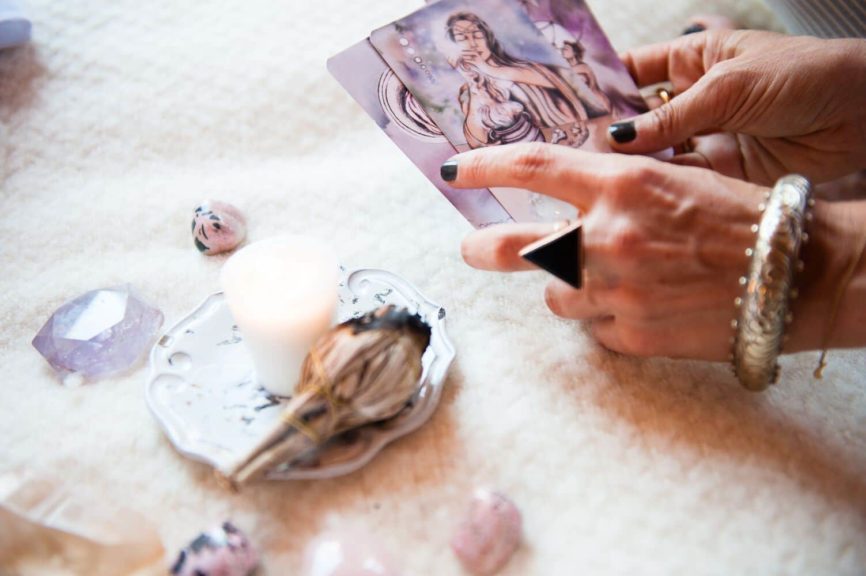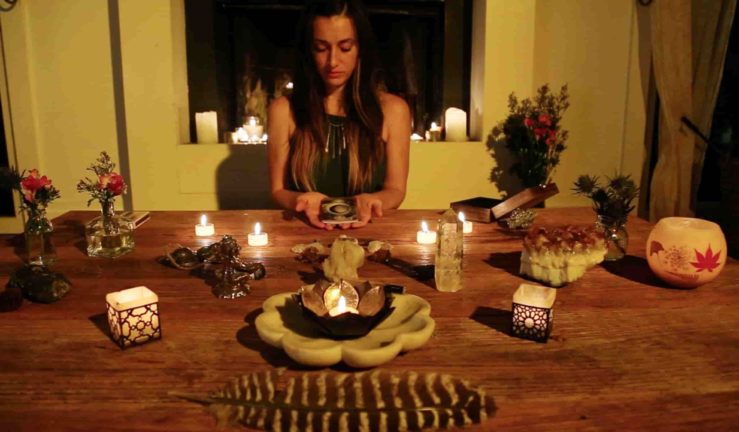Why Having an Altar Supports Your Emotional Well-Being

Having an altar adds beauty to your home and can bring immense benefit to your emotional, spiritual, and mental well-being. Your altar is an expression of your spirit, a place to go when you need healing or inspiration, and a sacred space to help you cultivate deep presence and daily ritual. There are no set rules for how your altar should look or feel. It can be very simple or more elaborate, as long as it feels beautiful and aligned for you personally.
Although how you build your altar is personal, there are some key things that can uplift and beautify the vibe as you set forth on a regular practice of soul-care for emotional well-being. Consider your altar as a symbol — how you show up and take care of it can become a compass for how you are showing up and caring for yourself. The more you tend to your altar, the more its healing and clarifying energy swells.
My Altar
Covered in sweet smells, candle flames, and sacred enchantments, my altar feels like a little campfire. It’s a familiar warm space that lights up my spirit and allows me to settle into my body as I restore my mind.
It’s where I meditate, journal, and contemplate.
It’s where I go when I feel overwhelmed or emotional.
It’s my landing pad when I need guidance or want to gather my inner resources.

The more I connect to my altar space, the more comforting and magnetic it becomes. I’ve had some of my heaviest cries and deepest prayers at my altar. I’ve been met by some of my greatest ideas or moments of clarity here, and I’ve experienced incredible stillness where my nervous system was finally able to soften.
When I regularly infuse my altar with meditations, prayers, and rituals, it swells into a deeply calming yet energized space, which helps me feel more emotionally fit. But when I ignore my altar and let it collect dust for too long, this ‘charge’ dissipates.
Do you sense the metaphor here? For me, neglecting my altar is a pretty good sign that I’ve also been neglecting my self-care needs, whether it be meditating, journaling, or working with my oracle cards. This neglect eventually finds its way into the many layers of my emotional health, both how I feel on the inside and how it is expressed on the outside.
Why Have an Altar?
There is a ceaseless rise and fall to life that can be both beautiful and overwhelming depending on the day. With this pulsing fluctuation, it’s important to have something that consistently grounds us.
Our environment impacts our energy and perspective, which in turn drives our emotions. An altar can lift the vibration of our home, bringing an element of beauty, protection, and inspiration into our space. Having a well-loved sacred nook where we can recharge our spirit and dissipate mental static is key to centering ourselves, especially amongst the many evolutions, losses, triumphs, growing pains, and teachings that we are all bound to walk through during our lifetime.
Whatever your practice may look like, having a daily moment with your altar allows you to land back home in your body, where you can feel more emotional ease rather than mentally stuck.
Create Your Own Altar for Emotional Well-Being
Your altar is your special place to set intentions, reconnect, meditate, manifest, grieve, journal, forgive, dream, and pray. Whichever enchantments you choose to dress your altar with, it’s important to periodically freshen up the design to match your current intention, which can change monthly or seasonally. Creating, recreating, cleaning, and clearing are all a part of respecting your altar, while keeping the good vibes alive.
There are many ways to approach building your own altar. Be intuitive with it, while using whatever inspirations align with your intention. With simple touches that are thoughtful and intentional, you can make any space feel sacred, no matter how big or small your altar is. Here are some tips to get you started or to give your current altar a boost:
- Use your intuition to decide which location in your home feels like the best spot for your altar. Choose an area that feels comfortable and inviting for you to sit quietly. If you have a hard time narrowing it down and want to take it a step further, use a compass to discover which direction your altar will be facing and decide which one best represents your intention. This added touch will boost its magic.
- Once you select your spot, gather all of your altarpieces and place it nearby. Then, move the air by opening your windows and burning your favorite smudge to help purify the space as you welcome in love and protection. The sacred smoke of white sage, sweetgrass, copal, or any favorite incense works wonders.
- Clean and clear any dust from your soon-to-be altar spot, so that it’s ready to be decorated.
- Add your special pieces in any order that feels most natural to you. Sense how your altar wants to look, and follow your intuition. I love having my candle in the center as a focal point, with crystals, flowers, and sacred objects I’ve found along the way, neatly placed in a symmetrical order. Plus I keep my journal and favorite oracle and tarot decks next to my altar. Feel free to also add a small cloth as a placemat, photos, hand-written letters, and anything else that amplifies your intention and soothes your emotional body.
- If you already have an altar, remove everything, clean the surface and surrounding areas, and reorganize it so that it feels fresh based on your current intentions.
- Once you’re done creating your altar, step back and take it in. If anything wants to shift, go for it. When everything feels just right, sit down, light a candle, be still with your breath for a moment, and then write freely in your journal for a few minutes.
Bring this Practice into Your Life
If you begin to feel disconnected or like your relationship with yourself is waning, it’s a good sign your altar needs a visit. Your special touch, unique spirit, and the warmth you carry inside can all be felt at the site of an altar. The act of creating it, and then consistently sitting with your altar will remind you of this each time. It’s also a reminder to drop in, pause, and return to trust.
The morning is an excellent time to focus on your personal rituals, with a daily sit at your altar being one of them. However, be sure to choose a time of day that you know you can commit to.
The cumulative impact of showing up daily, even if only for a few minutes, is key to feeling more emotionally balanced. With consistency, the deeper breaths, and little reminders that you receive at your altar will begin to pepper themselves throughout your day, giving you an access point from which you know you can return, any time you choose.
What Is the Fourth Dimension and Why You’re Already In It

The spiritual fourth dimension is a plane of existence that allows us to understand the internal processes behind everything we experience. Unlike the third dimension, where the physical predominates, the 4th dimension organizes time, dreams, emotions, and subtle energies. In this article, we explore what the spiritual 4th dimension is from the perspective of Matías De Stefano, as explained in the series Initiation, available on Gaia.
Table of Contents
- What Is the Spiritual Fourth Dimension?
- Differences Between the Third, Fourth, and Fifth Dimensions
- Time as a Structure in 4D
- Energetic Characteristics of the Fourth Dimension
- The Astral Planes in the 4th Dimension and Their Levels
- The 4th Dimension After Death
- Beings That Inhabit the Fourth Dimension
- Dreams, Time, and Manifestation in 4D
- The Fourth Dimension as a Bridge to the Fifth
What Is the Spiritual Fourth Dimension?
The spiritual fourth dimension is one of the nine dimensions of the universe and is part of the energetic structure that composes all reality. It is not a place one reaches, but a plane that coexists with physical reality. While in the third dimension we perceive shapes, objects, and limits, in the fourth, the focus is on the processes that pass through those forms: movement, change, and constant transformation. This level of consciousness allows us to observe what lies behind the visible and better understand how events are organized from the subtle.
In this dimension, time is not perceived as a continuous line, but as a network of simultaneous possibilities. It is the space where our emotions, thoughts, memories, and future projections are stored. Everything we feel and think leaves a trace on this plane, which acts as an energetic matrix from which material reality is later organized.
In the series Initiation, available on Gaia, it is shown how this intermediate level between the physical and the spiritual allows us to understand the patterns we repeat, the emotions that condition us, and the relationships that transform us. Through this understanding, real transformation from within becomes possible, recognizing that every change in matter begins first in the energetic field.
Differences Between the Third, Fourth, and Fifth Dimensions
Each dimension represents a different way of experiencing life. Although all are present at the same time, how we relate to each one depends on the level of consciousness from which we inhabit reality. Understanding these differences allows us to integrate experience from a broader perspective.
- Third dimension: This is the physical and concrete plane. Here, consciousness identifies with the body, time is experienced as a line, and reality is interpreted through separation and rational logic.
- Fourth dimension: This is the plane of time, emotions, and energy in motion. Here, invisible connections between events, dreams, and intentions begin to be perceived.
- Fifth dimension: This is a state of expanded consciousness where everything is experienced as part of a greater unity. Time and space integrate, and a complete vision of the soul’s purpose is accessed.
Time as a Structure in 4D
In the fourth dimension, time is not a straight line from past to future, but a living structure that contains all processes of change. What we understand as “past,” “present,” and “future” coexists within the same field, where everything can be perceived as simultaneous. It’s as if all life stages—from childhood to old age—were happening at the same time from another perspective.
This dimension does not focus so much on events themselves, but on how they transform over time. Here, what matters is not what happens, but the process that generates it: the emotion that accompanies it, the intention that drives it, the lesson it leaves behind. This is why accessing the fourth dimension means coming into contact with the dynamism of existence— with the invisible aspect that organizes the visible.
When one lives from this perspective, time ceases to be a limitation. It becomes a tool to understand cycles, review memories, transform repeating patterns, and open up to new possibilities. The fourth dimension doesn’t eliminate time—it expands it.
Energetic Characteristics of the Fourth Dimension
The fourth dimension is characterized by a type of energy subtler than that of physical matter, but denser than that of higher planes. Here, everything emotional and symbolic gains strength, and forms are molded by the frequency emitted from within. Personal vibration plays a fundamental role in how this plane is perceived and experienced.
- Active emotional field: Emotions are the dominant energy at this level. Everything you feel directly influences what you experience.
- Malleable reality: Forms are not fixed. They change according to your vibrational state and internal perception.
- Presence of symbols: Symbols, archetypes, and dreams play a central role. They act as a language of communication between planes.
- Echoes of thought: What is thought creates resonances. Ideas manifest more quickly and with greater clarity.
- Direct energetic interaction: There are no material filters. One being’s energy can immediately affect another if there’s no balance or conscious protection.
The Astral Planes in the 4th Dimension and Their Levels
Within the fourth dimension, there are different levels known as astral planes. These planes are not fixed places but vibrational states that correspond to the frequency of the one who inhabits or travels through them. Each plane reflects a particular type of experience and perception of reality.
- Lower astral: This is a dense level, where fear, unresolved emotions, and material attachments predominate. Here, energetic forms related to conflict, confusion, or suffering are manifested.
- Middle astral: This is a space of emotional and symbolic transition. At this level, consciousness begins to free itself from density, and processes of understanding and transformation become possible.
- Higher astral: This corresponds to higher frequencies, linked to clarity, harmony, and spiritual expansion. Here, perception is more luminous, and the soul prepares to access more subtle planes.
The 4th Dimension After Death
From the perspective of Matías De Stefano, when the physical body completes its cycle in the third dimension, consciousness does not disappear, but projects itself into the fourth dimension. This energetic projection is not random: it takes shape according to what the person has cultivated internally throughout their life. Emotions, beliefs, and mental patterns determine how this new reality is experienced, which is no longer limited by matter.
In this dimension, experience is entirely subjective and is constructed from within. Those who have lived with fear or attachment may generate chaotic or dense scenarios. On the other hand, those who have gone through life with greater balance access more harmonious planes. The fourth dimension neither judges nor rewards—it simply reflects and amplifies what consciousness already contains.
This transition does not imply a definitive separation but a continuous transformation. Energy remains in motion, and the soul retains the possibility to learn, release burdens, or prepare for new experiences. The 4th dimension functions as a reorganization field, where what has been lived is understood and the path is redefined before moving on to subtler levels of existence.
Beings That Inhabit the Fourth Dimension
In the fourth dimension, there are multiple life forms that do not have physical bodies but actively interact with the energetic field of human beings. Some of these presences offer guidance, others serve as teachers, and some feed on dense emotions. The relationship with these beings does not depend on chance but on the vibration from which one accesses this plane.
- Spiritual guides: They accompany processes of consciousness without imposing paths. Their presence is subtle and often manifests as intuitions, dreams, or synchronicities.
- Symbolic beings: They appear in archetypal forms in the dream or meditative world. They function as mirrors of the unconscious and help integrate internal aspects.
- Energetic parasites: They feed on fear, guilt, or anger. They often approach people with energetic cracks or emotional imbalance.
- Time beings: They are not tied to physical forms but to processes. They perceive reality as a web of simultaneous moments and can manifest according to the observer’s perception.
- Ancestral presences: They represent family, cultural, or planetary memories. They usually appear when it is necessary to recognize, heal, or integrate stories that still impact the present.
Dreams, Time, and Manifestation in 4D
In the fourth dimension, dreams are real experiences within an energetic plane that does not follow the laws of the physical world. Here, time does not follow a linear sequence but appears as a space of multiple possibilities. While sleeping, part of our consciousness detaches from the physical body and accesses this structure, where it can explore memories, anticipate situations, or encounter symbols that represent internal processes.
This level functions as a testing ground where thoughts and emotions take shape. Ideas that are repeated with clarity and coherence can solidify and begin to organize the reality that later manifests in the third dimension. That’s why dreams often anticipate events or offer insights to understand what’s happening in everyday life. They are not meaningless illusions—they are energetic movements within a plane of creation.
When one accesses the fourth dimension consciously, it becomes possible to recognize how events are generated before they happen. This awareness allows for the transformation of limiting beliefs, the release of trapped emotions, or the redirection of intentions more precisely. It is a way to actively participate in the manifestation process, using time not as a limitation, but as a tool for creation.
The Fourth Dimension as a Bridge to the Fifth
The fourth dimension plays an essential role as a space of transition between the density of matter and expanded consciousness. Here, the old is dismantled, internal energy is reorganized, and processes that were previously unconscious become clear. This plane is not a final destination but a stage that prepares the ground for accessing higher states of understanding and unity. Integrating this dimension is fundamental to evolving toward higher levels of consciousness.
To reach the fifth dimension, one must first go through and integrate the experiences of the third and fourth. It is not about “skipping” stages, but about recognizing how each one offers unique tools for the soul’s journey. In the fourth dimension, distortions are cleared, emotions are aligned, and the creative power of thought is acknowledged. Only then can one sustain the subtler and more coherent frequency that the consciousness of unity requires.
From this perspective, the fourth dimension is a plane of conscious transformation. It not only reveals what needs to be understood but also offers the means to do so. By inhabiting this level with presence and openness, one builds the bridge that enables the shift from a fragmented perception of reality to a broader, more integrated view aligned with the soul’s purpose.








